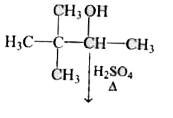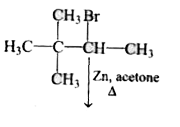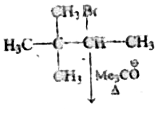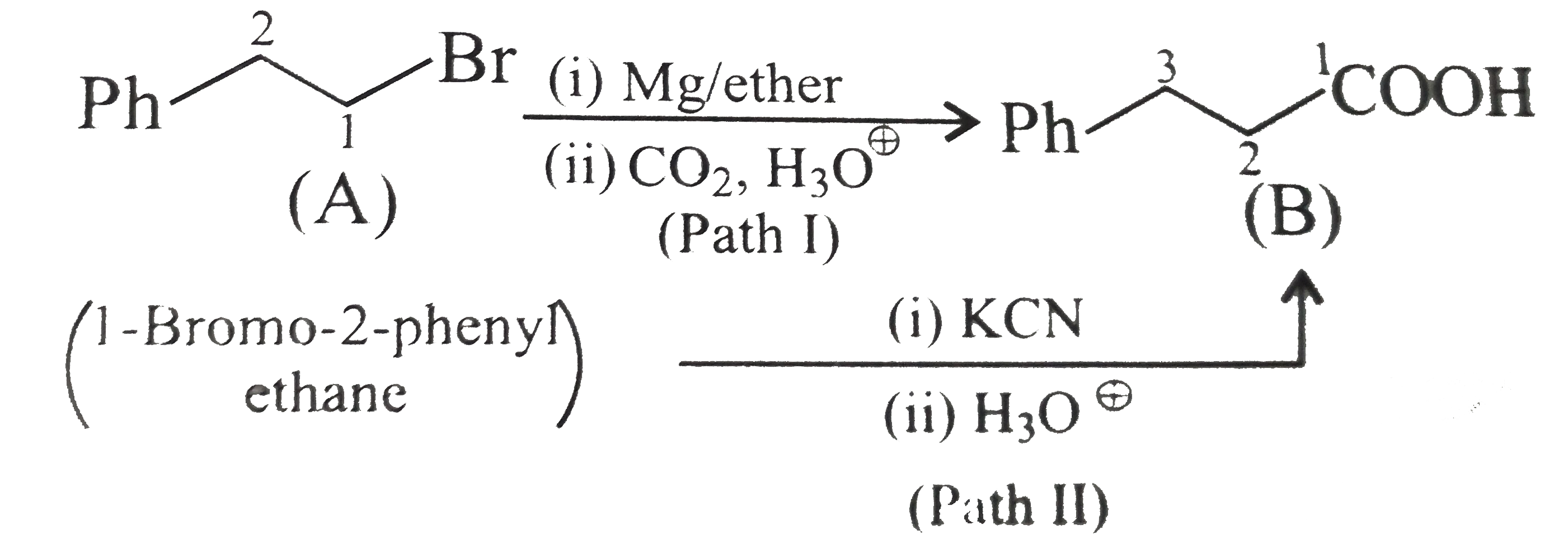The reaction that give good yield of n-Hexane is :-
CH3CH2Na/dry ether−−−−−−−−→CH2−Cl+CH3CH2CH2Cl
CH3CH2Cl+CH3CH2CH2CH2ClNa/dry ether−−−−−−−→
CH3−ClNa/dry ether−−−−−−−→+CH3CH2CH2CH2CH2Cl
All of them
The correct Answer is:A
To determine which reaction gives a good yield of n-hexane, we need to analyze the three reactions provided. All these reactions are types of Wurtz reactions, where two moles of alkyl halides react in the presence of sodium (Na) and dry ether to form alkanes.
1. Understanding Wurtz Reaction:
- The Wurtz reaction involves the coupling of two alkyl halides in the presence of sodium to form a higher alkane. The general reaction can be represented as:
2R-X+2Na→R-R+2NaX
- Here, R represents the alkyl group and X represents the halide.
2. Analyzing the First Reaction:
- In the first reaction, both alkyl halides are the same (let's say they are both hexyl halides).
- When these two react, they will only form n-hexane (C6H14) without any branching.
- Therefore, the yield of n-hexane will be high since there are no side products.
3. Analyzing the Second Reaction:
- In the second reaction, the alkyl halides are different (let's say they are butyl halides).
- The reaction can lead to the formation of multiple products, including butane (C4H10) and octane (C8H18), in addition to n-hexane.
- Since there are side products, the yield of n-hexane will be lower compared to the first reaction.
4. Analyzing the Third Reaction:
- In the third reaction, the alkyl halides are methyl halides.
- This reaction can produce ethane (C2H6) and decane (C10H22), along with n-hexane.
- Similar to the second reaction, the presence of side products will decrease the yield of n-hexane.
5. Conclusion:
- The first reaction, where both alkyl halides are the same and specifically chosen to be hexyl halides, will give the best yield of n-hexane.
- Therefore, the answer to the question is option (a), which corresponds to the first reaction.
Final Answer:
The reaction that gives a good yield of n-hexane is option (a).
- The Wurtz reaction involves the coupling of two alkyl halides in the presence of sodium to form a higher alkane. The general reaction can be represented as:
2R-X+2Na→R-R+2NaX
- Here, R represents the alkyl group and X represents the halide.
- In the first reaction, both alkyl halides are the same (let's say they are both hexyl halides).
- When these two react, they will only form n-hexane (C6H14) without any branching.
- Therefore, the yield of n-hexane will be high since there are no side products.
- In the second reaction, the alkyl halides are different (let's say they are butyl halides).
- The reaction can lead to the formation of multiple products, including butane (C4H10) and octane (C8H18), in addition to n-hexane.
- Since there are side products, the yield of n-hexane will be lower compared to the first reaction.
- In the third reaction, the alkyl halides are methyl halides.
- This reaction can produce ethane (C2H6) and decane (C10H22), along with n-hexane.
- Similar to the second reaction, the presence of side products will decrease the yield of n-hexane.
- The first reaction, where both alkyl halides are the same and specifically chosen to be hexyl halides, will give the best yield of n-hexane.
- Therefore, the answer to the question is option (a), which corresponds to the first reaction.
The reaction that gives a good yield of n-hexane is option (a).
Topper's Solved these Questions
Similar Questions
Knowledge Check
Cyclohexanol can be converted into cyclohexylamine by following two routes. Which of the following methods is expected to give good yield of cyclohexylamine ?
A B
B Cboth are equally suitableDneither of the two
Cboth are equally suitableDneither of the twoWhich is the following reactions is expected to give a fairly good yield of (CH3)3−C−CH=CH2?
A B
B C
C D
D
Consider the following reactions and answer A and B.

Yield of each step as actually carried out in laboratory is given above each arrow. What is overall yield of the reaction ?A0.6B0.21C0.4D0.68
Succinic acid (B) can be prepared by both nitrile and carbonation method as shown.

Both paths give good yields of (B).
(A) with Mg would lead to the loss of vicinal Br atoms to give alkene and MgBr2.
View Solution3−Phenol propanic acid (B) can be prepared by both nitrile and carbonation method as shown.

Path I gives a good yield of (B).
ӨCN initiates elimination reaction.
View Solution(i) Deficiency of which vitamin causes night-blindness ?
(ii) Name the base that is found in nucleotide of RNA only.
(iii) Glucose on reaction with HI gives n-hexane. What does it suggest about the structure of glucose ?
View SolutionCompound A on oxidation with OsO4/NaHSO3 following by reaction with HIO4 gives hexane 1,6 - di al .The structure of compound A can be given as
View SolutionThe reaction of ethylene bromide with zinc yields:
View Solution
